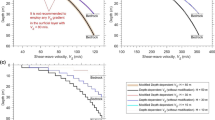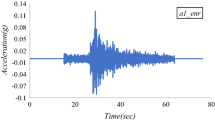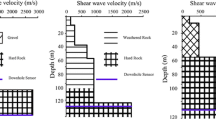Abstract
The selection of half-space or reference sites significantly influences site amplification studies. However, there are no well-defined guidelines in the literature. Generally, a layer with a local shear wave velocity (VS) of more than 760 m/s is considered a bedrock/half-space/reference site. This study attempts to formulate a rationale for selecting bedrock stiffness to be used as a half-space/reference site. For this study, VS,30 (average shear wave velocity of top 30-m soil strata from shear wave velocity measurements) and the site’s fundamental frequency (obtained from horizontal-to-vertical spectral ratio of ambient vibration records) were used as proxies to study the influence of bedrock/half-space and development of a rationale for their selection. This study uses strong-motion data from India’s sixty-two strong-motion stations and a few from Japan (Kik-Net). The results suggest that considering a site with a shear wave velocity of 760 m/s may not be suitable as a half-space/bedrock for most geomorphological conditions. The results also recognize a pattern that can help in the development of a mathematical model for determining the bedrock for a site using VS,30 and its fundamental frequency as a proxy.















Similar content being viewed by others
References
Adhikary S, Singh Y, Lang DH, Kumar R (2015) Effect of soil on seismic performance and vulnerability of RC frame buildings. In: SECED 2015 conference: earthquake risk and engineering towards a resilient world. Cambridge UK, pp 9–10
Bonilla LF, Steidl JH, Lindley GT et al (1997) Site amplification in the San Ferdinando Valley, California: variability of site effect estimation using S-wave, coda, and H/V methods. Bull Seism Soc Am 87:710–730
Boore DM (2005) On pads and filters: processing strong-motion data. Bull Seism Soc Am 95:745–750. https://doi.org/10.1785/0120040160
Borcherdt RD (1970) Effects of local geology on ground motion near San Francisco Bay. Bull Seism Soc Am 60:29–61
Bray JD, Rodríguez-Marek A (1997) Geotechnical site categories. In: Proceedings of the first PEER-PG&E workshop on seismic reliability of utility lifelines. San Fransisco, CA
Castellaro S (2016) The complementarity of H/V and dispersion curves. Geophysics 81:T323–T338. https://doi.org/10.1190/geo2015-0399.1
Converse A, Brady AG (1992) BAP basic strong-motion accelerogram processing software version 1.0
Dobry R, Borcherdt RD, Crouse CB et al (2000) New site coefficients and site classification system used in recent building seismic code provisions. Earthq Spectra 16:41–67
Falcone G, Romagnoli G, Naso G, Mori F, Peronace E, Moscatelli M (2020) Effect of bedrock stiffness and thickness on numerical simulation of seismic site response. Italian case studies. Soil Dyn Earthq Eng 139:106361. https://doi.org/10.1016/j.soildyn.2020.106361
Far H, Fatahi B, Samali B (2012) Effects of soil dynamic properties and bedrock depth on seismic response of building frames incorporation soil-structure interaction. In: Proc. 5th Asia-Pacific conference on unsaturated soils, pp 504–510
Field EH, Jacob KH (1995) A comparison and test of various site response estimation techniques, including three that are non reference- site dependent. Bull Seism Soc Am 86:991–1005
Kagami H, Duke CM, Liang GC, Ohta Y (1982) Observation of 1- to 5-second microtremors and their application to earthquake engineering. Part II. Evaluation of site effect upon seismic wave amplification due to extremely deep soil deposits. Bull Seism Soc Am 72:987–998
Konno K, Ohmachi T (1998) Ground-motion characteristics estimated from spectral ratio between horizontal and vertical components of microtremor. Bull Seism Soc Am 88:228–241
Kottke AR, Wang X, Rathje EM (2013) Technical manual of STRATA
Kramer SL (1996) Geotechnical earthquake engineering. Prentice Hall, Englewood Cliffs, New Jersey, USA
Kumar A, Mittal H, Sachdeva R, Kumar A (2012) Indian national strong motion network. Seismol Res Lett 83(1):29–36
Langston CA (1979) Structure under Mount Rainier, Washington, inferred from teleseismic body waves. J Geophys Res 84:4749–4762
Liu HP, Warrick RE, Westerlund RE et al (1992) Observation of local site effects at a downhole—and—surface station in the Marina district of San Fransisco. Bull Seism Soc Am 82:1563–1591
MacMurdo J (1824) Papers relating to the earthquake which occurred in India in 1819. Phil Mag 63:105–177
Manandhar S, Cho HI, Kim DS (2016) Effect of Bedrock stiffness and thickness of weathered rock on response spectrum in Korea. KSCE J Civ Eng 20:2677–2691
Mittal H, Kumar A, Ramhchhuani R (2012) Indian national strong motion instrumentation network and site characterization of its stations. Int J Geosci 3:1151–1167. https://doi.org/10.4236/ijg.2012.326117
Mittal H, Kumar A, Kumar A, Kumar R (2014) Analysis of ground motion in Delhi from earthquakes recorded by strong motion network. Arab J Geosci 8:2005–2017. https://doi.org/10.1007/s12517-014-1357-3
Mittal H, Kumar A, Wu YM, Kamal, Kumar A (2016) Source study of Mw 5.4 April 4, 2011 India—Nepal border earthquake and scenario events in Kumaon—Garhwal Region. Arab J Geosci 9:348. https://doi.org/10.1007/s12517-016-2330-0
Nakamura Y (1989) A method for dynamic characteristics estimation of subsurface using microtremor on the ground surface. Quaterly R Railw Tech Res Ins 30:25–33
Nogoshi M, Igarashi T (1970) On the propagation characteristics of microtremors. J Seism Soc Japan 23:264–280
Pandey B, Jakka RS, Kumar A, Mittal H (2016) Site characterization of strong-motion recording stations of Delhi using joint inversion of phase velocity dispersion and H/V curve. Bull Seism Soc Am 106:1254–1266. https://doi.org/10.1785/0120150135
Pandey B, Jakka RS, Kumar A, Sharma ML (2021) Site characterization of strong-motion stations of Himalaya and adjoining plains. Arab J Geosci. https://doi.org/10.1007/s12517-021-07231-y
Parolai S, Bindi D, Augliera P (2000) Application of the Generalized Inversion Technique (GIT) to a microzonation study: numerical simulations and comparison with different site-estimation techniques. Bull Seism Soc Am 90:286–297
Parolai S, Bindi D, Troiani L (2001) Site response for the RSM seismic network and source parameters in the Central Apennines Italy. Pure Appl Geophys 158:695–715
Parolai S, Richwalski SM, Milkereit C, Bormann P (2004) Assessment of the stability of H/V spectral ratio from ambient noise and comparison with earthquake data in the Cologne area Germany. Tectonophysics 390:57–73
Pitilakis K (2004) Site effects. In: Ansal A (ed) Recent advances in earthquake geotechnical engineering and microzonation. Springer, Dordrecht, pp 139–197
Riepl J, Bard PY, Hatzfeld D et al (1998) Detailed evaluation of site response estimation methods across and along the sedimentary valley of Volvi (EURO-SEISTEST). Bull Seism Soc Am 88:488–502
Rodriguez-Marek A, Bray JD, Abrahamson NA (2001) An empirical geotechnical seismic site response procedure. Earthq Spectra 17:65–87
Safak E (2001) Local site effects and dynamic soil behavior. Soil Dyn Earthq Eng 21:453–458
Schnabel PB (1973) Effects of local geology and distance from source on earthquake ground motion. PhD Thesis, University of California, Berkeley, California
Seed HB, Wong RT, Idriss IM, Tokimatsu K (1986) Moduli and damping factors for dynamic analysis of cohesionless soils. J Geotech 112:1016–1032
Seed HB, Idriss IM (1970) Soil moduli and damping factors for dynamic response analysis. Report No. EERC 70-10, University of California, Berkeley, California
Srivastava HN, Verma M, Bansal BK, Sutar AK (2015) Discriminatory characteristics of seismic gaps in Himalaya. Geomat Nat Haz Risk 6(3):224–242. https://doi.org/10.1080/19475705.2013.839483
Steidl JH, Tumarkin AG, Archuleta R (1996) What is a reference site? Bull Seism Soc Am 86:1733–1748
Triantafyllidis P, Hatzidimitriou PM, Theodulidis M et al (1999) Site effects in the city of Thessaloniki (Greece) estimated from acceleration data and 1D local soil profiles. Bull Seism Soc Am 89:521–537
Vucetic M, Dobry R (1991) Effect of soil plasticity on cyclic response. J Geotech Eng ASCE. https://doi.org/10.1061/(ASCE)0733-9410(1991)117:1(89)
Acknowledgements
The authors wish to thank the Ministry of Earth Sciences (MoES), Government of India, for providing financial support for the research (Project Grant Number MoES/P.O. (Seismo)/1(263)/2015). We are also thankful to the Head of Department, Department of Earthquake Engineering, and the laboratory staff for their help in testing and fieldwork.
Funding
This work was supported by Ministry of Earth Sciences (MoES), Government of India through a research project. Project grant number: MoES/P.O. (Seismo)/1(263)/2015.
Author information
Authors and Affiliations
Contributions
Bhavesh Pandey contributed to conceptualization, methodology, software, investigation, validation, writing—original draft, and data curation. Ravi S Jakka was involved in conceptualization, methodology, supervision, project administration, funding acquisition, and writing—reviewing and editing.
Corresponding author
Ethics declarations
Conflict of interest
The authors declare that they have no conflict of interest.
Additional information
Publisher's Note
Springer Nature remains neutral with regard to jurisdictional claims in published maps and institutional affiliations.
Supplementary Information
Below is the link to the electronic supplementary material.
Rights and permissions
About this article
Cite this article
Pandey, B., Jakka, R.S. Selection of an appropriate bedrock for site amplification studies. Nat Hazards 112, 2167–2195 (2022). https://doi.org/10.1007/s11069-022-05260-8
Received:
Accepted:
Published:
Issue Date:
DOI: https://doi.org/10.1007/s11069-022-05260-8




